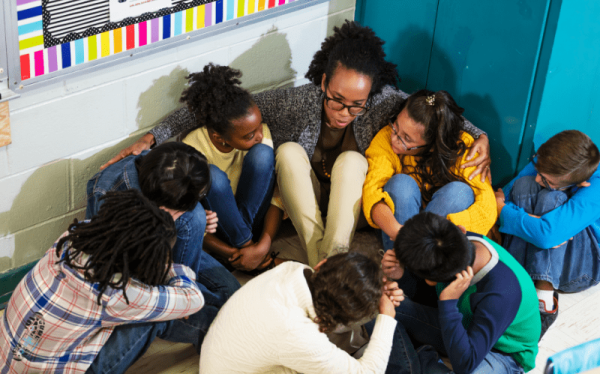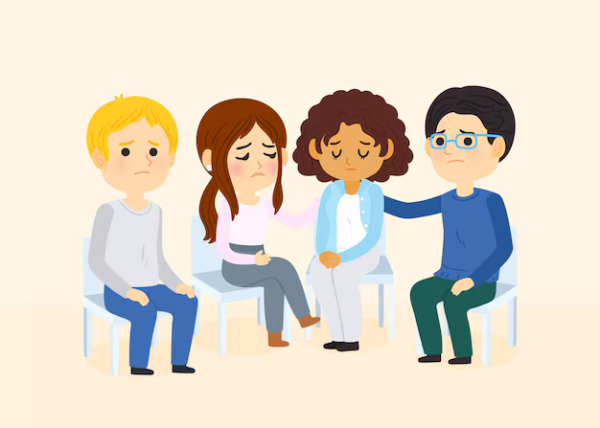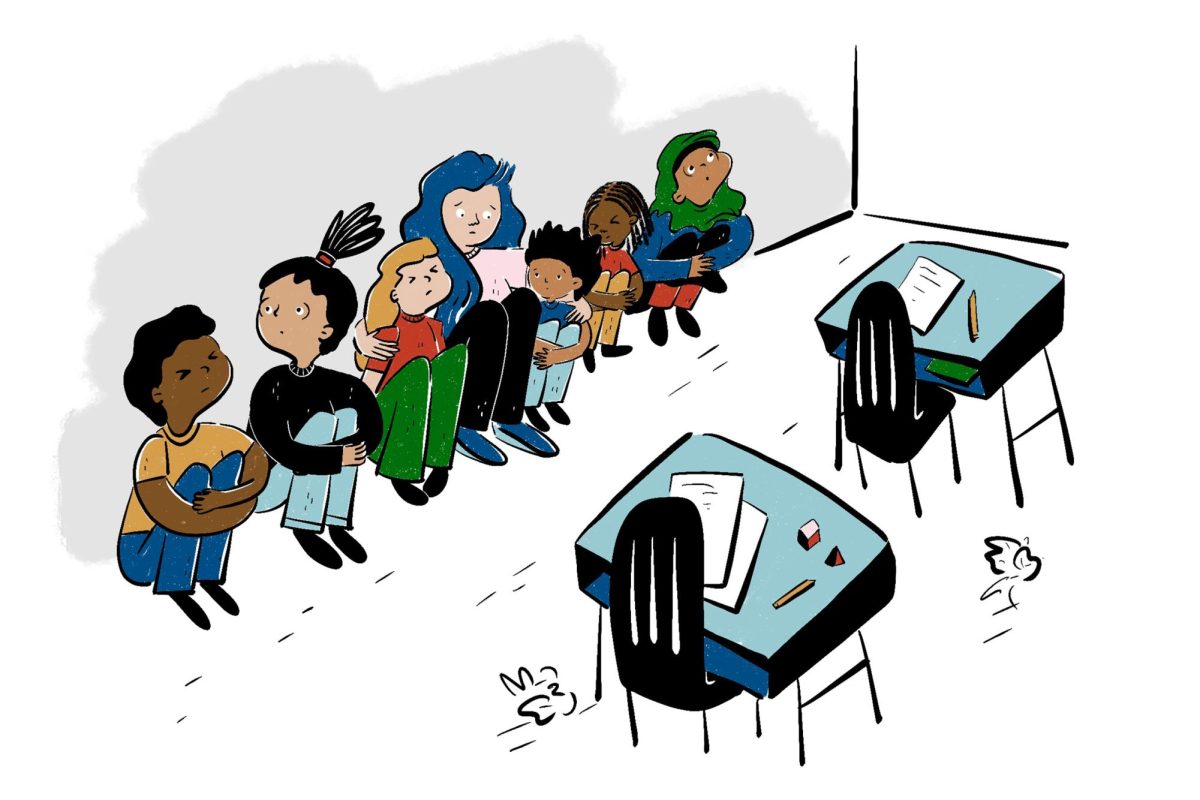“And then there is a lockdown where I had to stay in this class for like two hours because there was a stabbing near my building. It made me feel scared because I didn’t find out until after the school day. And what I did was I had to sit down quietly worrying, wondering what was going on.”
Valentina, a middle schooler in the New York City education system, recalls a time when staff failed to inform students what was happening during a lockdown, allowing fearful thoughts to come upon them. Living in constant fear is the reality for many students across the country due to the drills done to keep them safe during a real emergency like lockdowns.
“There was a shooting around here in Hudson Square and you know it was scary because some students heard and some students saw right over here. All the staff handled themselves very well, classes were staying put and there was a little bit of nervousness. If it ever gets really bad, we have to fight for our lives, barricade the door, make sure it is locked and stay out of sight and if the door gets broken down, you know it’s a scary thing to talk about but unfortunately that is what’s happening all over the country.”
James Whittaker is a teacher and dean at the NYC iSchool who has run multiple drills and has experienced a variety of school emergencies in the past 20+ years of teaching and 9 years at NYC iSchool. He speaks of his experience of a real shooting by his school and understands the extent teachers will have to take if an intruder comes inside to harm.
During a lockdown, students are taught to not make their location known through sounds and movement to avoid attracting intruders. Senior Chase Ford highlights that New York City school drills aren’t yet reaching these norms.
Chase comments, “I feel like anyone who breaks into a school I’m pretty sure also went to school and did the same exact practices. It’s also obvious if you put a blank piece of paper in front of a window, and all the doors are locked right, they obviously know if there’s people in the classrooms or most of them, so I just feel like it’s a waste of time.”
School emergency drills
In K-12 schools all over the states, drills help students and staff members prepare for unexpected emergencies. There are different types of drills, such as fire drills that teach students how to evacuate safely and swiftly during a school fire, earthquake drills that teach kids to get low and find cover to be protected from the hazard of falling objects, and the most traumatizing one, and lockdown drills that teach students and staff to hide and stay quiet when a possible intruder enters in a school building or are near the school that can cause danger.
When practicing a drill, the thought of a real school shooting and its possible effects can be traumatic. Students can also connect their abusive home life to school shootings and what they see happen to other students they find on the news. Staff already feel guilty that they might not be able to protect students if a real school shooting were to happen.
Most parents are not notified about what students are doing at school until after something happens like a drill, so they won’t be able to protect their children during an emergency.
School emergencies are becoming more common in K-12 schools after Covid-19
After the COVID-19 pandemic and lockdowns, many kids experienced significant challenges upon returning to school. The emotional toll of isolation, along with unemployment and financial stress, had a major impact on the ability to return to in-person learning. Students struggled with fear and anxiety as they slowly got back into the real world after such a long time. Restoring interactions with others was especially difficult, causing feelings of isolation and making it challenging for many people to find friends.

Social media has played a significant role in exacerbating these difficulties. While technology provided a way of interacting with people during times of separation, it also presented pressures that intensified feelings of inferiority and comparison. Many kids were overwhelmed by the fake lives that were portrayed online, worsening their self-esteem and self-confidence. Students struggled to disconnect from their phones and achieve control because they were constantly being shown new trends and checking social media notifications. As a result, the combination of social media’s effect and personal issues made returning to normal difficult for students.
Most children nowadays have unlimited access to the internet. They are exposed to things that they shouldn’t be seeing and are easily influenced to do these things.
According to Journal Of Pediatric Health Care, “approximately 88% of school shooters had at least one social media account, and 76% posted disturbing content of guns and threatening messages. Over 72% of shooters had at least one reported adverse childhood experience, and 60% reported being bullied in-person or online.” With these statistics, it is pretty clear that social media and accessibility are heavily influencing these bad intentions.
Schools failing to inform students about drills
Ms. Mangano, both a teacher and parent at the NYC iSchool, has a son who just started his education in Pre-K 4 located in New Jersey. Regarding when parents get notified at her son’s school, Ms. Mangano mentions that she is “notified after the lockdown drill. So far this year he has had two drills and I’m just happy as a parent to know that he went through that during the day and he usually shares at nighttime that it has happened as well, he likes to tell us how his day went.”
Having an insight on what a child’s day looks like are parents’ main priority to know if students were safe and enjoyed their day. But what if schools made parents more certain by informing them before a drill?
New York State Law Commissioner’s Regulation §155.17 requires districts to inform parents a week in advance of all safety drills schools will be conducting for students.  Although these regulations began in the 2024-25 school year, students are being informed through teachers and online messages other than an email from a school, and at different times, some are not being informed at all until at the moment announcements.
Although these regulations began in the 2024-25 school year, students are being informed through teachers and online messages other than an email from a school, and at different times, some are not being informed at all until at the moment announcements.
Based on a survey conducted for high school students at the NYC iSchool, 83.3% out of the 30 students who answered are informed about major safety drills like lockdown drills and fire drills through the loudspeakers or fire alarms. Being informed at the moment is a main factor contributing to fear students have during a drill. This is because students may confuse a drill with a real emergency worrying for their safety and thinking about many future scenarios until drills are lifted.
In an NPR article, high schooler Megan at Lake Brantley High School admits she mixed up a construction crew outside of her school with gunshots during a lockdown drill.
Being informed by a teacher came in second place based on the survey. Being informed by a teacher could look different for many students. Some teachers may give a heads-up to students a week before the drill happens, or a little heads-up the day of, but mostly a small reminder at the beginning of class which can be ineffective if the message isn’t heard by all students.
Kids who experience adverse childhood experiences are more prone to being afraid of school lockdowns
Many children are being raised by unfit parents. As explained by Levitsky Law Firm, the definition of being an unfit parent is failing to provide a safe, stable, and nurturing environment for their child. This can include a range of behaviors from neglect, physical abuse, substance abuse, mental instability, or any behavior that puts the child’s well-being at risk.
Unfortunately in today’s world, this is the environment that many children are experiencing. Many children are dealing with the hardships of an abusive household. Kids who experience violent abuse are more prone to being afraid of school lockdowns. A highschooler in The Trace remembers her early lockdown experiences and mentions,¨As she hunkered down beside her classmates, Jane remembered how she’d curl up into a ball to shield herself from her father’s physical abuse, which she and her mother had just escaped a few months earlier.” Not only do family situations and abuse fear students, but it can guide them to make bad decisions. This is called generational trauma which means negative experiences that one’s parents go through cause them to pick up behaviors and influence their children to act in such a way.
CNN’s approach to this topic illustrates a very important point. “Most school shooters tend to have histories of early childhood trauma, Peterson said, such as physical abuse, sexual abuse, neglect, having a parent who died by suicide or being raised by people with serious or persistent mental illness.” Being raised with trauma passes on the trauma making it a curse. Students are influenced because the pain of past experiences taking them over causes them to hate everything. Students also adopt abusive behavior because they are taught by people they should trust the most, their parents or caregivers, that doing such activity is the norm and should be done
Teachers have a huge responsibility

Mr. Whittaker feels, “very confident that, like we and our staff will, you know, be able to find kids, get kids out of the hallways, get safe, we, you know, we just have to communicate to the radios or over text message, um, when we’ve had some incidents in the past last year, we had a pretty scary incident and we were able to communicate to everybody and everybody kind of felt safe.¨
In these high-stress situations, many teachers feel pressured to ensure the safety of their children. They are in charge of locking the classroom doors from the outside, checking bathrooms to account for every student, ensuring that every student is present in the classroom, and keeping control over the classroom environment to keep everyone peaceful. The weight of this responsibility might cause feelings of guilt and stress if they feel like they haven’t done enough to protect their students.
In addition to their security responsibilities, teachers and school staff often have to handle their students’ emotional responses, providing reassurance and assistance during these stressful and emotional situations. The build-up of stress during these tasks can have a negative impact on their mental health, emphasizing the critical need for schools to provide mental health tools and training to assist educators manage these difficult situations properly. As a result, schools should prioritize the well-being of teachers/staff and foster a culture that appreciates their emotional and psychological safety, allowing them to carry out their vital duty with the confidence and support they require.
Ed Week informs that “ Twenty-four percent of teachers said in the fall 2023 survey that they were afraid they would be the victims of an attack,” only growing from the years before, and who knows, but the rates have the potential to keep growing.
U.S. problem
School shootings are more prone in the US because of the accessibility of guns. Guns are very easy to acquire in New York because of the age limit. Guns are legal for kids in New York who are at least 16 years old. In New York, minors who are at least 16 years of age can possess long guns. Most kids that are 16 attend school and can easily sneak something into school. However, some schools are aware of this and install metal detectors inside their buildings. In New York City a person needs a permit to purchase any gun and must register those guns. However, it is not illegal to purchase a handgun or long gun for the home or range or hunting. Some parents might have weapons for this specific reason and don’t hide them well enough. Some parents even keep it accessible. For example, adults might keep it in a drawer in the basement or even a safe but they tell their kids the password. This lack of security not only increases the risk of these weapons falling into the wrong hands but also highlights the need for better education and regulations around gun safety in homes with children. Additionally, conversations about responsible gun ownership within families can play a vital role in preventing potential tragedies.
“Take the Dunblane, Scotland mass shooting for example which happened in 1996 resulting in the deaths of 16 children and one teacher. Shortly after, the U.K. banned private ownership of guns as well as assault rifles. These new rules have resulted in a decline in gun violence; the U.K. has only experienced one mass shooting since the new restrictions were enacted, ” illistrates Protecting Our Students
Comparing the Dunblane, Scotland mass shooting to all the U.S shootings shootings, the list can go on: In 2018, there were 116 active shooter incidents in schools. It has exposed 25,332 students to on-campus gun violence, which has added to the growing fear behind active shooter events. Regulations on gun ownership aren’t earnestly looked on which Protecting Our Students adds on that schools felt safe to students before 1999 and psychiatrist Stephen Berkowitz, who spoke to the Washington Post about how safe students feel now reveals, “The perception of safety is no longer there.”
Solutions
“Once again, our minds go to why is America so obsessed with guns? There are already guns out there but why are these students who are usually silently suffering mentally able to get their hands on these guns? Why are adults not taking appropriate measures to ensure those guns stay out of the hands of these students? We also wonder why the schools are not being secured properly. We know there is a problem when someone can get on school grounds and inflict damage, so why aren’t there more security measures being placed on these schools to protect the students.”
These roaring questions by Protecting Our Students suggest new approaches to be implemented in schools where safety training drills that have been proven to cause trauma, can be ineffective when run under trauma, and the number of people with the intention of danger has grown, to ensure students, staff and parents can feel safe in a place where they or their child goes for the majority of their year.
 One of the most important approaches to preparing kids for lockdowns is therapy. Therapy needs to be advocated and provided to kids struggling with trauma from school drills and also to students struggling mentally to prevent school lockdowns from happening in the first place. This could either be a professional therapist or anybody who has the ability to calm nerves. Yale Medicine explains a simple, yet responsible action a caregiver can take to comfort children on the topic of school emergencies: “Your ability to listen calmly to your children’s concerns is one of the most powerful ways of helping them feel safe and secure. You are the most important source of help for your children.”
One of the most important approaches to preparing kids for lockdowns is therapy. Therapy needs to be advocated and provided to kids struggling with trauma from school drills and also to students struggling mentally to prevent school lockdowns from happening in the first place. This could either be a professional therapist or anybody who has the ability to calm nerves. Yale Medicine explains a simple, yet responsible action a caregiver can take to comfort children on the topic of school emergencies: “Your ability to listen calmly to your children’s concerns is one of the most powerful ways of helping them feel safe and secure. You are the most important source of help for your children.”
Everyone has had firsts in their lives. A first day of school, a first time trying a new sport, a first time traveling alone, a first win. Before these first, you have had no experience. This can cause feelings of afraidness, questions can come up and overall nervousness. But some form of reassurance was there along with you that helped keep your head up even if it was self reassurance and that is exactly what therapy can do. It tells students that their feelings and thoughts are okay, that they aren’t alone with their concerns, and learn ways to cope with their fears so getting to safety stays as their main priority. Therapy should also be the main resort for students struggling mentally for the same reasons. Adults, teenagers, and kids should know that therapy is a safe sport to express all feelings verbally that are harming them without expressing them physically in a way that harms others along with them.
Schools should implement free sources of therapy and acknowledge symptoms of what struggling mentally looks like so that they can provide therapy fast to those who need it. Symptoms like being depressed and angry at others all the time, having a low attention span, and social isolation are just some.
Another important approach is for more restrictions and rules on gun ownership to be implemented as laws and for schools. For example, the minimum age to purchase handguns under a federally licensed firearms dealer is currently 21 years of age. It is currently possible for an 18-year-old to buy a handgun legally in a private sale. Keep in mind that by the time students in America reach the 12th grade, some will be 18.
Sandy Hook Promise admits “Many of them not only bought their guns legally, they also bought multiple high-capacity detachable magazines, making it easier to reload their guns quickly” about underaged people who have mostly targeted schools.
Schools that require backpack checks and metal detectors make sure that no weapons are brought in and used in a school and help stop the danger before it even comes in. Practicing backpack checks and using metal detectors in high crime areas or just to implement safety will help students normalize coming unarmed. Yes, it is almost normal.
A small suggestion that will make the biggest change in preparing students before a drill is suggested by sophomore student Ashe at the NYC iSchool. “Telling kids to get their coats on like when it’s cold outside, just so that we’re all not freezing. Or telling them to, like wrap up their task a couple minutes early, just so if they’re taking a test or something, they’re not right in the middle of it. That’s always the worst.”
Over the past 10 years of experience, Mr.Whittaker suggests, “..make sure we’re kind of staying off over our cell phones so the teachers can kind of communicate. It’s important when it seems to be quiet, because if there were something serious going on, right, you really want to be quiet, we want to stay safe and aware, you know? I think like when we have these panic situations, you know, it’s important to drill and be able to, like, be familiar with what you’re doing.”
The same idea of awareness seems to pop up the most, a goal that New York is trying to prevent with their new law but still needs to be promoted so that it is properly in effect.
According to the Head of Security at Niagara Fall City School District in Audacy, “The biggest change is we have to notify the parents of the drills prior to conducting the drill so the parents know, which I think is a good idea, to let the parents know these drills are coming, so there’s no misconceptions of a drill versus a real event.”
End result
Readers should care because gun violence is a rising issue all over the globe and these experiences that children are going through shouldn’t even be an issue. The experiences that children are going through—living in fear, undergoing lockdown drills, and grappling with the reality of potential threats—shouldn’t even be a part of their childhood. Instead of focusing on learning and personal growth, children are exposed to a stressful environment that hurts their emotional development and academic ability. These lockdown drills, meant to prepare them for a worst-case scenario, often create a false sense of security, while also adding on anxiety and trauma.
As a community, we must advocate for meaningful change, ensuring that safety and peace become important aspects of educational environments, rather than only precautions against violence. It is society’s responsibility to ensure that children and teens can enjoy their years free from the elements of violence and fear.
Teachers and staff, who often find themselves vulnerable and at risk, shouldn’t be ignored but rather provided with the support and resources they need to foster a secure environment. Their role is not just to educate but to ensure the safety and well-being of their students, however many are left feeling not really prepared for the challenges posed by potential threats. When teachers and staff lack proper training and mental health resources, it can lead to an environment of fear and uncertainty that ultimately impacts everyone in the school community.
New York City high school teacher Mohammad Jehad Ahmad didn’t know for a whole 6 years what she had to do when practicing drills. She informs Chalkbeat “… in my first year doing it, I would lock the door and keep teaching.” Even though schools have training for staff, it is important to invest more time in it, so that safety protocols are known in an instant and students shouldn’t feel vulnerable but rather protected. Teachers and staff work hard to figure out ways to keep all students safe.
Furthermore, acknowledging the emotional toll that these situations take on educators is critical. Free sources of therapy should always be provided whenever staff feel they need it. They too hold a great amount of responsibility and often bear the weight of their student’s panic and fear. It’s time to acknowledge teachers and staff’s critical role and support them with the skills necessary to successfully deal with the challenges of gun violence in schools.
Security guards at NYC iSchool are in charge of over 400 students and believe that “in any situation that you’re in, you always have to remain calm because if you tend to tense up or you notice that someone else can be off with that and then you have a whole situation where everybody’s running, not knowing what to do, where to go, so rules are important so you guys know what to how to handle yourselves if there is a situation,” revealing the importance on why staff and students should feel confidence when running the drills.
Students shouldn’t feel vulnerable but rather protected. Teachers and staff work hard to figure out ways to keep all students safe, often going above and beyond to implement measures that foster a secure and supportive atmosphere. Their dedication not only reflects their commitment to education but also highlights the urgent need for systemic support to enhance these efforts. When schools create safety plans, conduct drills, and engage in open discussions about safety, they send a clear message: the well-being of students is a top priority.
However, this responsibility cannot fall only on teachers and school staff; it requires a collaborative approach involving administrators, mental health professionals, parents, and the community. By combining these efforts, we can create an environment in which students feel valued and secure, allowing them to focus on their studies, friendships, and personal development. By advocating for full safety measures, we not only address immediate concerns but also foster an environment in which every student has the resources to thrive academically and emotionally. Just as teacher Ms. Ly at the NYC iSchool said, “I’m strong AF. And I am fast” revealing exactly how students should feel.








